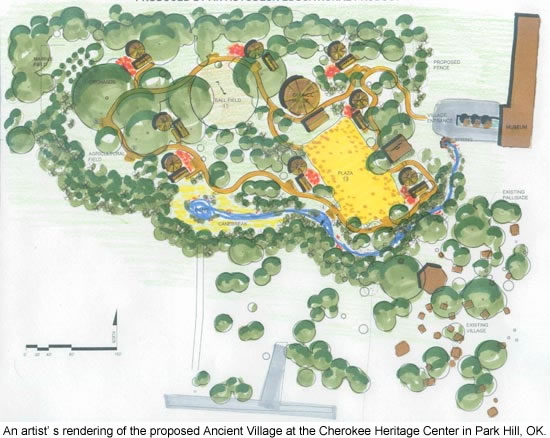 |
Canku Ota
|
 |
|
(Many Paths)
|
||
|
An Online Newsletter
Celebrating Native America
|
||
|
December 1, 2010 - Volume
8 Number 12
|
||
|
|
||
|
New Ancient Village
At Cherokee Heritage Center In Works
|
||
|
by Will Chavez- Cherokee
Pheonix Reporter
|
||
|
CHC Executive Director Carey Tilley said Cherokee Nation Cultural Tourism is putting up $250,000 for the first of three phases for the new village. He said funds must be raised for the second and third phases. Overall, the project is estimated at $1 million. Construction has started, and he said he hopes all phases are done by spring 2011. The new village will have 13 stations for demonstrations such as basket weaving and canoe making. Eight pairs of winter and summer homes, winter and summer council houses, an orchard, ball field, gardens and a re-circulating stream are other features. Plants and trees native to the Southeast and Oklahoma that are important to Cherokees will also be planted. The new village will be historically accurate with larger winter homes and a plaza, he said. The current council house will remain, but the small, dome winter homes called osies in the current village were inaccurate and demolished. “They were substantial buildings,” Tilley said of historical osies. “Several families could have lived in them during the winter. They’re not little, sweat lodge-looking things.” He said another difference, which is not in the current village yet essential in Cherokee life, is a plaza. “Archeologically, they show up everywhere. That was the center of community activity for most of the year. They would have gathered in the council house for certain events, but the social life was centered around that plaza.” The time period for the new village will also change from the 1600s to the early 1700s. The Yamasee War between the British colonists and tribes in the Southeast erupted in 1715 in South Carolina, Tilley said. When it was over, hardly any tribal people remained between Charleston, S.C., and the Cherokee Nation, which led to more trade between Cherokees and colonists. During this period, Cherokees still made traditional baskets and practical items and used stone tools, although steel tools and utensils were available through trade. “It changes their world after that Yamasee War. So this is sort of a last glimpse of the Cherokees before there is a major shift in their material culture,” Tilley said. An important part of the experience will be the people employed as villagers, he said. Six year-round employees currently work in the village, and six more are hired for summer. Tilley said through tribal programs, there should be no problems hiring villagers once it is finished. Another
change includes moving the marble field near the CHC entrance into
the village. There will also be no palisade surrounding the expanded village. “We have found that Cherokees did not have palisaded villages, so we’re making an effort to be accurate,” Tilley said. He also said research shows that towns had “no-build” zones between the fires of the winter and summer council houses and the area leading to water. “Obviously they had an intent that you not build on that line. Generally, that is a southeasterly direction to water,” Tilley said. “That’s still important today, going east to water from the fire.” Professor Alfred Vick at the University of Georgia’s College of Environmental and Design, assisted the CHC with its plans. He said the current village site was not ideal because the topography was not flat, especially for a plaza. So land adjacent to it and an overflow parking area will be used for the new village. The new village will encompass about five acres, a fraction of the size of a true village from the 1700s. The Ancient Village was built in 1967 and “was ahead of its time” because not a lot of people were promoting living history, Tilley said. He said its buildings are “beyond repair” except for the council house, which will be used as an interpretive area. |
|
|
||
|
|
||
| Canku Ota is a free Newsletter celebrating Native America, its traditions and accomplishments . We do not provide subscriber or visitor names to anyone. Some articles presented in Canku Ota may contain copyright material. We have received appropriate permissions for republishing any articles. Material appearing here is distributed without profit or monetary gain to those who have expressed an interest. This is in accordance with Title 17 U.S.C. Section 107. | ||
|
Canku Ota is a copyright ©
2000, 2001, 2002, 2003, 2004, 2005, 2006, 2007, 2008, 2009, 2010
of Vicki Barry and Paul Barry.
|
||
 |
 |
|
|
The "Canku
Ota - A Newsletter Celebrating Native America" web site and
its design is the
|
||
|
Copyright ©
1999, 2000, 2001, 2002, 2003, 2004, 2005,
2006, 2007, 2008, 2009, 2010
of Paul C. Barry.
|
||
|
All Rights Reserved.
|
||
 PARK
HILL, OK – The current master plan for a revised Cherokee Heritage
Center includes a new and expanded Ancient Village.
PARK
HILL, OK – The current master plan for a revised Cherokee Heritage
Center includes a new and expanded Ancient Village.